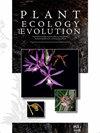Diversity and distribution of ferns and clubmosses in the eastern canyons of Isalo National Park, Madagascar
IF 1.3
4区 生物学
Q3 PLANT SCIENCES
引用次数: 0
Abstract
Background and aims – In contrast to the flowering plants, the pteridophyte flora of Madagascar is still understudied. While several studies have been published on the eastern and central parts of the island, there are currently few works dedicated to the pteridophytes of southwestern Madagascar. The aim of this work is to increase the knowledge of the pteridophyte flora of the Isalo massif in southwestern Madagascar. It presents a checklist of Isalo’s pteridophytes and an analysis of the diversity and distribution patterns of pteridophyte communities across ecological gradients in the eastern canyons of Isalo. Material and methods – Eighty plots were placed in six canyons. In each plot, pteridophyte species abundance was inventoried, as well as several ecological and geomorphological variables. A census in the field and observations on specimens in herbaria were carried to make a checklist of all the pteridophyte species known for Isalo. Statistical analysis was carried out to understand the pteridophyte diversity and distribution patterns in the Isalo’s canyons: (1) exploratory analysis (FAMD and HCPC) highlights the general patterns of ecological gradients, (2) a rarefaction curve was used to compare species diversity, and (3) co-inertia analysis investigated the relationship between ecological gradient and pteridophyte communities. Key results – In total, 60 species of ferns and lycophytes have been recorded in the massif, including ten endemic species to Madagascar and 11 species reported for the first time in the Isalo massif. Species diversity is especially high in the northern canyons (Anjofo, Andramanero, Antsifotra) in contrast to the middle (Maki and Rats) and southern (Namaza) canyons. Fern distribution patterns were correlated to a combination of environmental factors, highlighting species-specific ecological preferences.马达加斯加伊萨洛国家公园东部峡谷中蕨类植物和俱乐部苔藓的多样性和分布情况
背景和目的--与开花植物相比,马达加斯加的翼手目植物区系研究仍然不足。虽然已经发表了一些关于马达加斯加岛东部和中部的研究报告,但目前专门研究马达加斯加西南部翼手目植物的著作还很少。这项工作的目的是增加对马达加斯加西南部伊萨洛山丘翼手目植物区系的了解。它列出了伊萨洛的翼手目植物清单,并分析了伊萨洛东部峡谷生态梯度中翼手目植物群落的多样性和分布模式。材料和方法--在六个峡谷中设置了 80 个小区。在每个小区内,都调查了翼手目植物物种的丰度以及一些生态和地貌变量。通过实地普查和对标本馆标本的观察,编制了一份伊萨洛地区所有已知翼手目植物物种的清单。为了解伊萨洛峡谷的翼手目植物多样性和分布模式,还进行了统计分析:(1)探索性分析(FAMD 和 HCPC)突出了生态梯度的一般模式;(2)稀有度曲线用于比较物种多样性;(3)共惯性分析研究了生态梯度和翼手目植物群落之间的关系。主要成果 - 在伊萨洛山丘共记录到 60 种蕨类植物和翼手目植物,其中包括 10 种马达加斯加特有物种和 11 种首次在伊萨洛山丘报道的物种。北部峡谷(安乔福、安德拉马内罗、安齐福特拉)的物种多样性特别高,与中部(马基和拉特)和南部(纳马扎)峡谷形成鲜明对比。蕨类植物的分布模式与多种环境因素相关,凸显了物种特有的生态偏好。
本文章由计算机程序翻译,如有差异,请以英文原文为准。
求助全文
约1分钟内获得全文
求助全文
来源期刊

Plant Ecology and Evolution
PLANT SCIENCES-
CiteScore
2.20
自引率
9.10%
发文量
27
审稿时长
>12 weeks
期刊介绍:
Plant Ecology and Evolution is an international peer-reviewed journal devoted to ecology, phylogenetics and systematics of all ‘plant’ groups in the traditional sense (including algae, cyanobacteria, fungi, myxomycetes), also covering related fields.
The journal is published by Meise Botanic Garden and the Royal Botanical Society of Belgium.
 求助内容:
求助内容: 应助结果提醒方式:
应助结果提醒方式:


